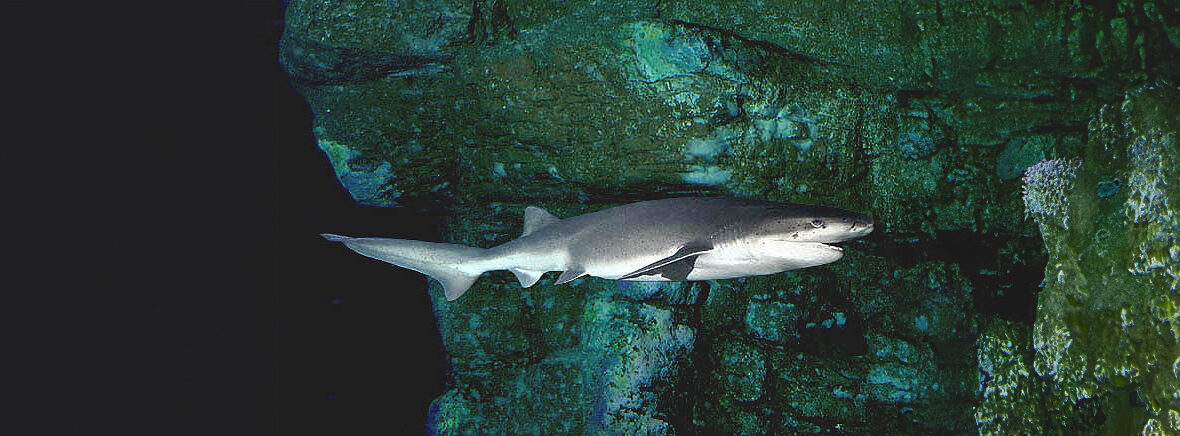
While most shark species have 5 gill slits, the broadnose sevengill shark, formerly improperly known as cow shark & mud shark, displays 7 gill slits. These peculiar sharks can be found along the coastlines of western United States, western Mexico, western and southern South America, South Africa, eastern Asia, southern Australia, and New Zealand. Due to the threats of overfishing and bycatch (being accidentally caught with other intended fish) these sharks are listed as Vulnerable by the IUCN. Their populations are also decreasing.
First the Stats…
Scientific name: Notorynchus cepedianus
Weight: Up to 401+ lbs.
Length: Up to 11 feet
Lifespan: Up to 49 years
Now on to the Facts!
1.) The top jaw possesses jagged, cusped teeth, the teeth on the bottom jaw are comb-shaped.
2.) Just like many other sharks, they are counter-shaded (the dorsal – top is a different color than the ventral – bottom) The dorsal surface is silver-gray to brown, while the dorsal portion is very pale.
3.) There is a subspecies called the sharpnose sevengill shark.
4.) Sevengill sharks have been around for approximately 200 million years.
5.) In circa 1930s – 1940s fisheries along the coast of California would go after these sharks, severely depleting their numbers. Then again in circa 1980s – 1990s sport fishermen targeted them.
But wait, there’s more on the broadnose sevengill shark!
6.) Their scientific name as a whole literally translates to “Lacepede’s back snout”.
7.) Other common names for these critters are cowshark, spotted cow shark, ground shark, bluntnose sevengill shark, broad-snout, seven-gill cowshark, seven-gilled shark, spotted seven-gill shark, Tasmanian tiger shark, cação-bruxa (Portuguese), cañabota gata, gatita, tiburón de 7 gallas, gevlekte zevenkieuwshaai (Dutch), tiburón pinto, and tollo fume (Spanish), ebisuzame and minami-ebisuzame (Japanese), Kammzähner and Siebenkiemiger Pazifischer Kammzähner (German), koeihaai (Afrikaans), platneus-sewekiefhaai (Afrikaans), platnez and requin malais (French), k’wet’thenéchte (Salish), siedmioszpar plamisty (Polish), and tuatini (Maori).
Did you know…?
These critters are in the Guinness World Records as having the most gill slits of any known shark.
8.) They have been spotted at depths of up to 1,870 feet.
9.) While feeding on a variety of creatures like rays, chimaeras, cetaceans, pinnipeds, bony fishes, and animal falls (seafloor carrion – dead animals), they tend to favor other sharks, such as the gummy sharks, and true cowsharks.
10.) These sharks are the definition of opportunistic feeders, preying on pretty much anything that can fit in their mouth. These critters are also known for feasting on seabirds, sea snails, crustaceans, drowned rats, and even drowned humans.
But wait, there’s still more on the broadnose sevengill shark!
11.) Once they have gorged themselves on a meal they can go weeks before having to feed again.
12.) Great white sharks, orcas, and even each other serve as predators.
Did you know…?
These sharks are considered potentially dangerous to humans, due to their aggressive nature towards people in the wild (divers) and even while being housed in public aquariums.
13.) Even though they are primarily nocturnal (active at night), they can also occasionally feed during the day.
14.) These sharks are ovoviviparous (pups develop in eggs inside the female until ready to be born.
15.) Females undergo up to a 12 month gestation (pregnancy) that can yield a whopping 95 pups!
Now a Short Broadnose Sevengill Shark Video!
Be sure to share & comment below! Also, check out the Critter Science YouTube channel. Videos added regularly!
Want to suggest a critter for me to write about? Let me know here.
Some source material acquired from: Wikipedia & IUCN
Photo credit: Ross Robertson



